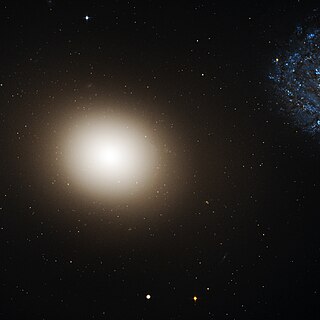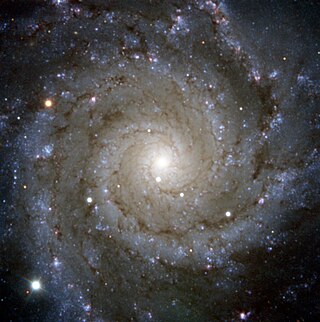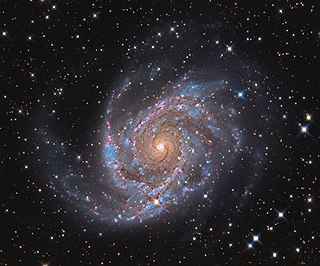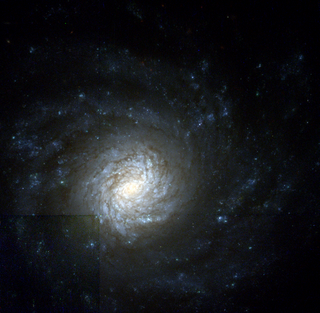
Telescopium is a minor constellation in the southern celestial hemisphere, one of twelve named in the 18th century by French astronomer Nicolas-Louis de Lacaille and one of several depicting scientific instruments. Its name is a Latinized form of the Greek word for telescope. Telescopium was later much reduced in size by Francis Baily and Benjamin Gould.

Messier 100 is a grand design intermediate spiral galaxy in the southern part of the mildly northern Coma Berenices. It is one of the brightest and largest galaxies in the Virgo Cluster and is approximately 55 million light-years from our galaxy, its diameter being 107,000 light years, and being about 60% as large. It was discovered by Pierre Méchain in 1781 and 29 days later seen again and entered by Charles Messier in his catalogue "of nebulae and star clusters". It was one of the first spiral galaxies to be discovered, and was listed as one of fourteen spiral nebulae by Lord William Parsons of Rosse in 1850. NGC 4323 and NGC 4328 are satellite galaxies of M100; the former is connected with it by a bridge of luminous matter.

Messier 58 is an intermediate barred spiral galaxy with a weak inner ring structure located within the constellation Virgo, approximately 68 million light-years away from Earth. It was discovered by Charles Messier on April 15, 1779 and is one of four barred spiral galaxies that appear in Messier's catalogue. M58 is one of the brightest galaxies in the Virgo Cluster. From 1779 it was arguably the farthest known astronomical object until the release of the New General Catalogue in the 1880s and even more so the publishing of redshift values in the 1920s.

Messier 60 or M60, also known as NGC 4649, is an elliptical galaxy approximately 57 million light-years away in the equatorial constellation of Virgo. Together with NGC 4647, it forms a pair known as Arp 116. Messier 60 and nearby elliptical galaxy Messier 59 were discovered by Johann Gottfried Koehler in April 1779, observing a comet in the same part of the sky. Charles Messier added both to his catalogue about three days after this.

Messier 74 is a large spiral galaxy in the equatorial constellation Pisces. It is about 32 million light-years away from Earth. The galaxy contains two clearly defined spiral arms and is therefore used as an archetypal example of a grand design spiral galaxy. The galaxy's low surface brightness makes it the most difficult Messier object for amateur astronomers to observe. Its relatively large angular size and the galaxy's face-on orientation make it an ideal object for professional astronomers who want to study spiral arm structure and spiral density waves. It is estimated that M74 hosts about 100 billion stars.

Messier 88 is a spiral galaxy about 50 to 60 million light-years away from Earth in the constellation Coma Berenices. It was discovered by Charles Messier in 1781.

Messier 108 is a barred spiral galaxy about 28 million light-years away from Earth in the northern constellation Ursa Major. It was discovered by Pierre Méchain in 1781 or 1782. From the Earth, this galaxy is seen almost edge-on.

NGC 6946, sometimes referred to as the Fireworks Galaxy, is a face-on intermediate spiral galaxy with a small bright nucleus, whose location in the sky straddles the boundary between the northern constellations of Cepheus and Cygnus. Its distance from Earth is about 25.2 million light-years or 7.72 megaparsecs, similar to the distance of M101 in the constellation Ursa Major. Both were once considered to be part of the Local Group, but are now known to be among the dozen bright spiral galaxies near the Milky Way but beyond the confines of the Local Group. NGC 6946 lies within the Virgo Supercluster.

NGC 4725 is an intermediate barred spiral galaxy with a prominent ring structure, located in the northern constellation of Coma Berenices near the north galactic pole. It was discovered by German-born British astronomer William Herschel on April 6, 1785. The galaxy lies at a distance of approximately 40 megalight-years from the Milky Way. NGC 4725 is the brightest member of the Coma I Group of the Coma-Sculptor Cloud, although it is relatively isolated from the other members of this group. This galaxy is strongly disturbed and is interacting with neighboring spiral galaxy NGC 4747, with its spiral arms showing indications of warping. The pair have an angular separation of 24′, which corresponds to a projected linear separation of 370 kly. A tidal plume extends from NGC 4747 toward NGC 4725.

NGC 1316 is a lenticular galaxy about 60 million light-years away in the constellation Fornax. It is a radio galaxy and at 1400 MHz is the fourth-brightest radio source in the sky.

NGC 2997 is a face-on unbarred spiral galaxy about 40 million light-years away in the faint southern constellation of Antlia. It was discovered March 4, 1793 by German-born astronomer William Herschel. J. L. E. Dreyer described it as, "a remarkable object, very faint, very large, very gradually then very suddenly bright middle and 4 arcsec nucleus. This is the brightest galaxy of the NGC 2997 group of galaxies, and was featured on the cover of the first edition of Galactic Dynamics by James Binney and Scott Tremaine.

NGC 2207 and IC 2163 are a pair of colliding spiral galaxies about 80 million light-years away in the constellation Canis Major. Both galaxies were discovered by John Herschel in 1835.

NGC 4639 is a barred spiral galaxy located in the equatorial constellation of Virgo. It was discovered by German-born astronomer William Herschel on April 12, 1784. John L. E. Dreyer described it as "pretty bright, small, extended, mottled but not resolved, 12th magnitude star 1 arcmin to southeast". This is a relatively nearby galaxy, lying approximately 72 million light-years away from the Milky Way. It is a companion to NGC 4654, and the two appear to have interacted roughly 500 million years ago. NGC 4639 is a member of the Virgo Cluster.

NGC 3190 is a spiral galaxy with tightly wound arms and lying in the constellation Leo. It was discovered by William Herschel in 1784. NGC 3190 is member of Hickson 44 galaxy group, estimated at around 80 million light years away, and consisting of four galaxies in a tight group - NGC 3193 is fairly featureless, NGC 3187 is a dim but striking spiral galaxy and NGC 3185 has a barred spiral structure with an outer ring. It is also a member of the NGC 3190 Group of galaxies, which is a member of the Leo II Groups, a series of galaxies and galaxy clusters strung out from the right edge of the Virgo Supercluster.

NGC 3169 is a spiral galaxy about 75 million light years away in the constellation Sextans. It has the morphological classification SA(s)a pec, which indicates this is a pure, unbarred spiral galaxy with tightly-wound arms and peculiar features. There is an asymmetrical spiral arm and an extended halo around the galaxy. It is a member of the NGC 3166 Group of galaxies, which is a member of the Leo II Groups, a series of galaxies and galaxy clusters strung out from the right edge of the Virgo Supercluster.

NGC 4041 is the New General Catalogue identifier for a spiral galaxy in the northern circumpolar constellation of Ursa Major. It is located an estimated 70 million light years from the Sun. The morphological classification of SA(rs)bc indicates this is a spiral galaxy the lacks a bar; the 'rs' means it has a weakly-formed ring structure, and the 'bc' indicates the spiral arms are moderately to loosely wound.

NGC 7552 is a barred spiral galaxy in the constellation Grus. It is at a distance of roughly 60 million light years from Earth, which, given its apparent dimensions, means that NGC 7552 is about 75,000 light years across. It forms with three other spiral galaxies the Grus Quartet.

NGC 4424 is a spiral galaxy located in the equatorial constellation of Virgo. It was discovered February 27, 1865 by German astronomer Heinrich Louis d'Arrest. This galaxy is located at a distance of 13.5 million light years and is receding with a heliocentric radial velocity of 442 km/s. It has a morphological class of SB(s)a, which normally indicates a spiral galaxy with a barred structure (SB), no inner ring feature (s), and tightly-wound spiral arms (a). The galactic plane is inclined at an angle of 62° to the line of sight from the Earth. It is a likely member of the Virgo Cluster of galaxies.

NGC 536 is a barred spiral galaxy located in the constellation Andromeda. It is located at a distance of circa 200 million light-years from Earth, which, given its apparent dimensions, means that NGC 536 is about 180,000 light years across. It was discovered by William Herschel on September 13, 1784. It is a member of Hickson Compact Group 10, which also includes the galaxies NGC 529, NGC 531, and NGC 542. It belongs to the Perseus–Pisces Supercluster.

NGC 1325 is a flocculent spiral galaxy situated in the constellation of Eridanus. Located about 75 million light years away, it is a member of the Eridanus cluster of galaxies, a cluster of about 200 galaxies. It was discovered by William Herschel on 19 December 1799.




















